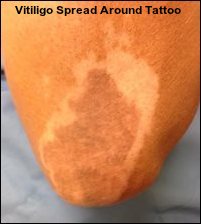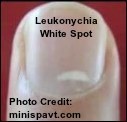| Click Here for Best View |
 |
||||||||||||||||||||||||
This Newsletter Has Been Generously Sponsored By:
|
||||||||||||||||||||||||
|
If you’ve ever surfed the web, then you’ve likely seen the claims of vitiligo cures and miracle treatments. I know that plenty of our members have seen these stories, testimonials, and ads, because we regularly receive phone calls and emails seeking validation of such products or claims. Twenty years ago, after seeing your doctor, if you wanted additional information about vitiligo, you had to go to the library or make an expensive long distance phone call to an organization like VSI. However, in today’s technological environment, if you have a question, you can find the answer in just a few short keystrokes, right? Who Can You Trust? The problem is that the internet is filled with biased, unsubstantiated, and conflicting information. Separating fact from fiction and staying on top of the latest information is not for the novice! VSI is dedicated to providing valid, unbiased, and current information, which requires collaboration with a strong professional network of clinicians, researchers, healthcare providers, and public policy leaders, as well as attending ongoing educational sessions and meetings. As a nonprofit organization, all of VSI’s efforts: publications, programs, services, professional meetings and memberships, our office (staffed 5 days a week), server space, website, IT programmers, newsletter software, and much more, is sustained by the generous support of our donors. We’d like to take this opportunity to extend our most heartfelt gratitude If each person reading this newsletter made an annual donation Will You Support VSI’s Campaign to Transform the Future of Vitiligo?
Sincerely,
What About Tattooing and Should Someone with Vitiligo Get a Tattoo? The following article and photos have been reproduced “The answer is not straightforward, and requires some discussion about the purpose of the tattoo, the stability of vitiligo, and the expectations of the patient. Some people want to tattoo a vitiligo spot with their skin color, so that it covers the spot and their skin looks even. Others want to tattoo a picture or phrase over their spots to serve as a distraction, and others just want to get a tattoo on a part of the body that doesn’t have spots, but they heard that it might make their vitiligo worse. I will address all of these options here, as well as their pros and cons. First of all, for a number of reasons it is usually a bad idea to try to tattoo the color of your skin over a vitiligo spot to hide it. It is very difficult to match the color of your skin with tattoo ink, partly because the skin color changes with the seasons, sun exposure, and age. But also, the color of ink tattooed deep into the skin is altered significantly when light travels from the ink, through layers of the skin, to your eye (the Tyndall effect). So whatever color you select for the tattoo, it will look a lot different once it’s placed into the deep skin (the dermis) through a tattooing needle. Another problem is that the vitiligo spot may get larger with time, and so even if the color match were perfect, the spot may grow, creating a ring of white skin around the tattoo, which won’t do much to help hide the vitiligo.
Alternatively, I have seen many patients with tattoos over their vitiligo spots that are interesting pictures or phrases that become a distraction from the white spots, and these often work well. For example, one patient had the phrase “You are beautiful” tattooed over her vitiligo.
This approach does not depend on matching the skin color or shape of the spots, so it can work well. However, any trauma or damage to the skin, including puncturing the skin with a tattoo needle, can worsen vitiligo at the site, or create a new vitiligo spot. This process is called koebnerization, which is common to see on the knees of children with vitiligo, for example, because they often fall, scrape their knees, and vitiligo appears. Another patient I saw with this was an avid mountain biker, who frequently banged up his legs, and had many vitiligo spots up and down his shins. This may or may not happen if you have vitiligo and get a tattoo, but it is more likely to happen if your disease is actively spreading, such that you are getting new spots or your old ones are getting larger. It is a particular risk if you tend to get vitiligo spots where your skin is damaged, from a burn or a cut, for example. So in summary, if you have vitiligo and you’re thinking about getting a tattoo, consider a few things first. It is rarely a good idea to try to tattoo a vitiligo spot the same color as your skin, because the color will not likely match exactly, the color of the skin changes, and the spot may get larger. If your vitiligo is active (you’re getting new spots, old ones are getting larger, or spots appear when you damage your skin), a tattoo might make it worse, or cause a new spot. But many people with vitiligo have chosen to get a tattoo with good results. It is not likely that the tattoo ink itself will fade with vitiligo, since vitiligo is not lightening of all color, but loss of the color-producing cells called melanocytes. So tattoo ink shouldn’t be affected by vitiligo. In the end, the decision is up to you, and if you decide it’s worth the risk to get the tattoo, have fun with it!” What About Micropigmentation? Micropigmentation uses equipment similar to devices used in specialized tattooing methods. However, the pigments used are metabolically inert and are different from tattooing ink. Click here to learn more about the differences between micropigmentation and tattooing Click here to follow Dr. Harris on his blog
Calling all Medicare Vitiligo Patients!
Part of the problem is that currently there is no accepted standard for coverage of vitiligo treatments. Each company has their own policies and guidelines, many times based on outdated and incorrect information. What most people may not realize is just how much private insurance coverage can be affected by Medicare policies. Over 55 million Americans are now covered by Medicare or Medicare Advantage, making it the nation’s largest health insurance program. Consequently, many, if not most, insurance providers establish their baseline standards and procedures to follow the Medicare model. We have been in touch with Medicare and have been told that if we can provide a Medicare letter of denial for a vitiligo treatment, then they will try to help us set a standard of coverage. If you are reading this newsletter and you, or someone you know, was denied coverage for a vitiligo treatment by Medicare, please contact VSI immediately. You could help make a difference for future insurance coverage for ALL vitiligo patients! Click Here to Contact VSI
What's On Your Mind? Q. How does a person get vitiligo? Is it contagious?
Q. If I marry a person with vitiligo, will our children have vitiligo?
Highlights of recently-published medical Nail Abnormalities in Patients with Vitiligo Researchers from Istanbul, Turkey noted that nail abnormalities (NAb) have been documented in various other autoimmune diseases associated with vitiligo, and suggested that the same should be apparent in vitiligo patients. With prior research on the topic being limited to a single report, they conducted a two-year study to determine the frequency and type of nail abnormalities in vitiligo patients compared to non-vitiligo control.
Study Findings: The researchers observed an increased incidence of NAb among those in the vitiligo group (78% exhibiting at least one nail abnormality) as compared to those in the control group (55%), but found no correlation between the presence of NAb and patient age or vitiligo duration. The 3 Most Frequent NAb Observed in the Vitiligo Group:
Absent lunula (13%) Editor’s note: An absent lunula on the little finger is considered normal. However, small or no moons on the other fingers can indicate an underactive thyroid gland, as well as deficiency of vitamin B12 or iodine which feeds the thyroid gland. Because research has shown the risk to develop autoimmune thyroid disease to be 2.5 times higher among those with vitiligo than in the normal population, if you notice a nail abnormality, you should check with your doctor about thyroid testing.
Genetic Research Update From the As many of you know (and MANY of you have contributed samples to), Dr. Richard Spritz of the University of Colorado at Denver and his team from around the world have been researching the genetics of vitiligo for many years. His previous genome-wide association studies (GWAS 1 & GWAS 2) found 27 genetic loci (where a gene sits on one or more of the 23 chromosomes that make up human DNA) related to the development of vitiligo in patients of European ancestry as well as linkage to several other autoimmune diseases. Recently, his team completed further research, including GWAS 3, in those of European ancestry, and combined the new results with those from the previous GWAS, examining a total of 4,680 vitiligo cases and 39,586 controls. This new research identified 23 new loci that are quite likely to be associated with vitiligo, and 7 more that are suggestive of being involved, thus doubling the number of known genes increasing the risk of developing vitiligo. Most of the newly-identified loci are associated with regulating immune and cell processes, with some also associated with other autoimmune diseases and some with the regulation of melanocytes. Dr. Spritz feels like they have a new understanding of how these genes work together to cause vitiligo and possibly related diseases such as autoimmune thyroid disease, pernicious anemia, Addison’s disease, rheumatoid arthritis, adult-onset type 1 diabetes, and lupus. Because their research shows that many of these genetic variations are in areas that control how the genes function and regulate themselves, it may lead to specific areas to identify for vitiligo treatments as well as better understanding and treatments of these other diseases.
Vitiligo Research Study in New York City.
Needling Clinical Trial in New Jersey
NEW! - Support VSI Through Ebay
Earn Funding for VSI 3 Ways When You Shop! Your Online Shopping Can Benefit VSI!
|
|||||||||||||||||||||||
| Copyright © 2017 Vitiligo Support International Inc. All rights reserved. Reproduction or republication strictly prohibited without prior written permission A Vitiligo Support International, Inc. financial statement is available upon written request from the Virginia Office of Consumer Affairs. Mail requests to: Virginia Department of Agriculture and Consumer Services, Office of Consumer Affairs, P.O. Box 1163, Richmond, Virginia 23218. Unsubscribe from the original email |
||||||||||||||||||||||||














